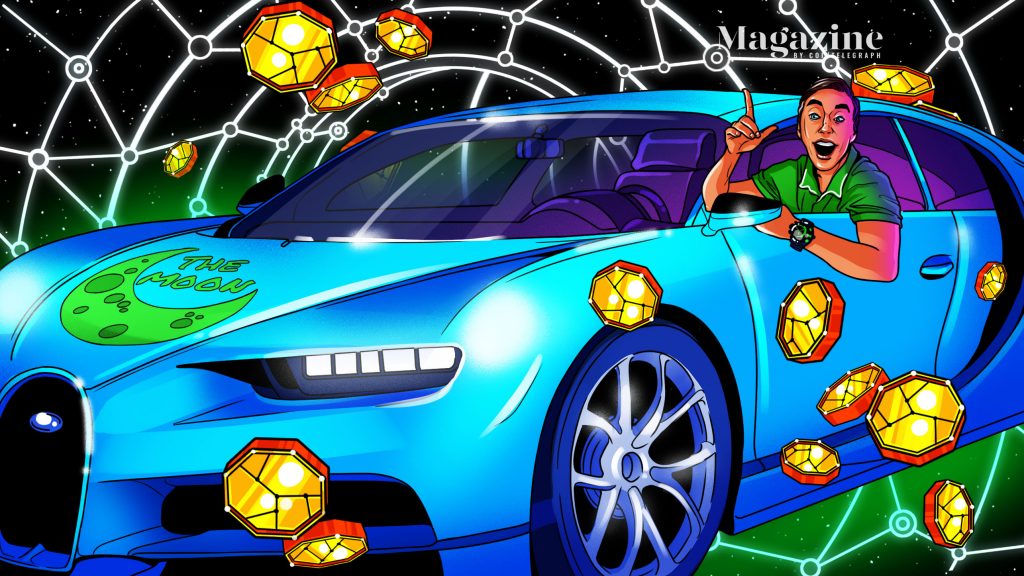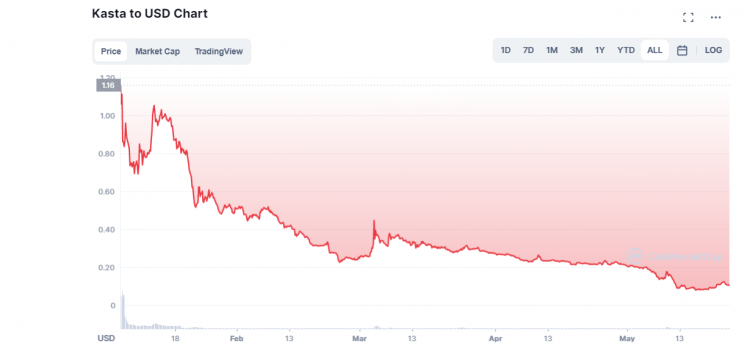In the space of a few short years, former high-school dropout cashier from Sweden Carl “The Moon” Runefelt has been transformed into a top crypto influencer who shares videos of his life of private jets, supercars and million-dollar watches that inspire his followers and annoy his critics.
Drawing from quantum physics, he has an explanation for his unlikely success — the universe isn’t real but is merely a construction of our minds in which we are able to rearrange reality to match our wildest dreams. Despite critics and controversy, Runefelt continues on a mission to inspire his followers to live their dreams.
Law of attraction
“My parents told me that I should stop this nonsense. They said Bitcoin was shady,” Runefelt recalls.
Runefelt, 27, came across Bitcoin and cryptocurrency in 2018 while researching ways to make money to climb out of his lowly job as a cashier. He was quickly captivated, seeing large price swings and the fact that coins that had recently peaked at $20,000 were bought for mere dollars only a few years earlier. This path seemed promising, and he committed himself to learning.

Runefelt already had a YouTube channel, and very much like Gajesh Naik, the 13-year-old star of a previous Journeys article, he soon began making videos to explain the things he had learned, with a tutorial on CoinMarketCap’s site being among his first. People loved watching his videos, Runefelt says, and his fan base grew quickly. Soon enough, sponsors came knocking.
“When you teach, you push yourself to learn. So, I started making videos, and my my channel grew very, very fast in the beginning, getting 1,000s of views per video.
First, the money started to trickle in via sponsorships and affiliate deals, where Runefelt would earn money whenever his viewers clicked a link or created an account on a certain crypto exchange or service. Though his parents were initially very worried, imploring him to finish his education or “get a real job” instead of sitting at the computer all day, their tune changed when Runefelt began making several thousands of dollars a month “just doing YouTube and crypto” — far more than he earned at the supermarket, a job he quit some months later in November 2018.
Awesome to hear @TheMoonCarl share his crypto journey from cashier in Sweden to entrepreneur and top influencer and at his Dubai office @CointelegraphZN @Cointelegraph pic.twitter.com/eYJbzlGjpT
— Elias Ahonen.eth (@eahonen) May 17, 2022
Almost all the money Runefelt earned, he invested into cryptocurrencies and companies related to them. Though there have been many losses to scams on the way, overall, the approach has gone well, with Runefelt investing in 350 crypto startups and telling me he makes millions per month through liquidity pools and yield farming. While Cointelegraph can’t confirm the numbers, he certainly has an extravagant lifestyle befitting the newly rich.
Today, Runefelt sees himself as more a businessman than an influencer, managing his empire through TheMoonGroup, which he founded in November 2021. One of his primary entrepreneurial projects is Kasta, a payments app that he co-founded in early 2021. “Payments should be dead simple, like sending an SMS,” Runefelt says. The project’s token, KASTA, has fallen significantly since launch.

Runefelt also has a non-crypto YouTube channel, called simply Carl Runefelt, which he describes as a “lifestyle channel” where he can be seen in videos such as “BUYING MY DREAM BUGATTI,” “I’M BUYING A MILLION DOLLAR JACOB WATCH!!!!!” and “I PAID $80,000 FOR THIS 8 HOUR PRIVATE JET FLIGHT!!!” to name a few recent titles. These videos lack the affiliate links of his crypto channel and feature an energetic and excited Runefelt presenting his luxurious Dubai lifestyle to the outside world.
Why does Runefelt need to show off? Privately enjoying watches and sports cars and jets is one thing, but why post about them for everyone to see? What does he have to prove? Though it goes against everything his (and the author’s) Nordic culture taught him, Runefelt’s answer has an undeniable logic.
“The only thing I want to do is inspire people to become as wealthy as they possibly can — just open their minds and show them that everything is possible. Stop limiting yourself and start realizing that you deserve your dream life.
It was only 3.5 years ago, after all, that Runefelt lived an entirely different life. Today, he sees himself as an example to other versions of his past self, who see little inspiration around them. “I was watching similar videos when unsuccessful,” he recalls, adding that if he could make it in such a short time, anyone can. The first step is to visualize goals and write them down.
But why should people desire and work toward wealth?
“It’s more about the freedom that you get from wealth. With freedom, I think comes happiness because you decide what you want to do with your own time. Time is the true wealth anyways. Money is just something that you use as a tool to free up your time. When you have all the time in the world, you’re the wealthiest person in the world,” Runefelt philosophizes. When he gets up in the morning, he does only the things he wants to — who can argue with that?
The Secret
His philosophy, however, goes deeper and is weirder than that, with Runefelt using quantum physics to explain his outlook on life. The universe and everything in it, he insists, is merely a hologram. “It’s just an illusion. It’s just energy. Vibrational energy — and our consciousness is the only thing that really truly exists,” he explains with complete assuredness. Following this, it is via consciousness that reality is materialized using the Law of Attraction. To create an exciting reality, one must have the audacity to dream big. “I literally am shaping my reality because it’s all energy anyways. In quantum physics, we learn that everything that we perceive to be solid is in fact not solid,” he declares.

This can lead to big changes, Runefelt assures. “Three years and BOOM, you can be anything you want — a famous musician, a billionaire. It doesn’t matter what you want to do, anything can be done with the right mindset,” he insists.
“You can materialize anything in this world — whether it’s a Bugatti, whether it’s your dream life, your dream relationship, your dream business or your employees. Everything that I have today was intentionally put in place by me.
What Runefelt describes — give or take some quantum mechanics — appears exactly as the premise of The Secret, a 2006 Rhonda Byrne self-help bestseller, which claims that people can change their lives using thoughts. The idea is not new — Byrne herself was inspired by The Science of Getting Rich, published in 1910. This Law of Attraction, which many consider a revival of ancient philosophies, comes from the New Thought spiritual movement based on the mid-19th century teachings of Phineas Quimby.
The Law of Attraction is, however, considered a pseudoscience for the simple reason that its effect cannot be scientifically proven due to survivorship bias and availability error, among other limitations. While many attribute their success to the system, there is no proof that it will work for everyone.

Tricks of the trade
“I don’t like making those thumbnails, but if I don’t, my channel dies,” explains Runefelt, whose YouTube videos feature thumbnails with comically exaggerated, open-mouthed expressions and all-caps titles followed by a half-dozen exclamation or question marks. This approach clearly differentiates him from Nicholas Merten, another Journeys’ crypto YouTube star, who made it clear that “the last thing you’ll find on my channel is me making a shock-face.” This is something Runefelt acknowledges but explains that “the YouTubers getting the most views all use clickbait,” referring to peers such as MMCrypto and BitBoy Crypto.

“I study what I need to do — don’t hate the player, hate the game,” he rationalizes, explaining that YouTube’s algorithm favors highly emotional expressions, capital letters and attention-grabbing punctuation. If he were to instead make a video with a “normal” thumbnail and descriptive title, “no one is watching it, even if it was the best video that month. It’s very sad that the world works like that, but it’s just how it is,” he admits.
Though Runefelt is adamant that YouTube is today just a hobby, his team continues to spend time getting the titles and thumbnails just right to maximize views. Sometimes, this means changing the titles after publication in order to increase clicks, which he says has caused some misunderstandings. “We simply use whatever words are more likely to gain traction at any given time. The titles are meant to get clicks” instead of serving as recommendations or predictions. The purpose is to actually get people to watch the video itself, he emphasizes.
He considers his Attention Deficit Disorder, which caused him to drop out of high school, an asset in his work today because “when you are doing something you really, really like, focus becomes a superpower — someone with ADD will have laser focus,” he explains.
Though Runefelt has managed to channel a potential disadvantage into an advantage, his younger brother who suffers from Downs Syndrome and a myriad of other diseases, including two near misses with cancer, has been less lucky. “His hospital journal is, like, it’s one of the biggest ones that doctors have ever seen,” Runefelt describes, adding that seeing these struggles “led me to start my charity where I’m raising money for children with disabilities.” Racing4Charity is done through his Formula Two racing team.
“I am giving $30,000 myself in Bitcoin every race weekend, and if my driver, Ralph Boshung, wins a race, I’m giving $100,000.” Along with a large image of Runefelt’s face, the car also features a QR code for Bitcoin donations.

Breaking the Law of Jante
Runefelt grew up in Sweden’s capital of Stockholm, where he dropped out of high school due to an inability to concentrate because of his ADD. He describes the following years as ones of aimless floating and partying. Though he eventually settled into a job making $1,500 per month as a supermarket cashier, his parents remained worried about his future prospects. Runefelt was not satisfied and refused to accept his position in life.
“I decided ‘I’m going to be rich; I’m going to be successful; and I’m going to shape my reality. I’m going to live my dream life.’ I started basically visualizing my dream life.
Imagining himself driving a Ferrari instead of catching the train to work in the mornings, “I said these positive mantras to myself every single day to condition my mind and my subconscious into actually believing that these things are true,” he explains.
For the moment, they were patently false. “I am happy. I am successful. I love myself. I love my life. I’m living my dream life. My parents are proud of me. I’m proud of myself,” he lists. He even went through the motions of pretending to buy private jets and yachts, putting an image of a business jet as his phone background for encouragement. His peers couldn’t understand his mindset.

As he read more about wealth, Runefelt came to the view that the entire banking system was “a big Ponzi scheme” because central bankers are “printing money out of thin air and then they have the audacity to charge interest on this money which doesn’t even exist.” At times, this inspired a certain nihilism to compete with his ambitions — if the world was corrupt, why feel bad about doing poorly in life? Beginning to research alternatives to the “stupid” system, he first encountered narratives around precious metals, which inspired him to use a lion’s share of his monthly savings to buy silver and gold.
While these themes of dreaming big and distrusting the system are ones that American readers may find familiar and even unoriginal, it must be pointed out how culturally unconventional they are in his native Sweden. In fact, Runefelt’s behavior goes completely against The Law of Jante, a Nordic “sociological term to denote a social attitude of disapproval toward expressions of individuality and personal success,” whose overarching principle is that no one is to think themselves as better than others.
“When I left Sweden, I had to give up 70% of everything I made so far with crypto, YouTube, and investments. That’s horrible — I think taxes are a scam.
This, in part, explains the country’s high tax rates and the fact that tax records are public in the country. Instead of wishing for private jets, Swedish society expects people to find peace with their lot in life and place their trust in the system, something Runefelt refused to do. With cryptocurrency itself billed as “trustless” and beyond “broken” governments, it is easy to see how the message gains little transaction in the Nordic countries where trust and transparency are the default and material success is something to be understated.
“I’ll never move back,” declares Runefelt, who moved to tax-free Dubai in 2020. “People encourage success here — in Sweden people don’t like it so much.”

Elias Ahonen
BTC bounceback, ETH’s ‘legit crisis,’ Elon Musk’s DOGE stunt: Hodler’s Digest, Jan. 31–Feb. 6
The best (and worst) quotes, adoption and regulation highlights, leading coins, predictions and much more — one week on Cointelegraph in one link!
Read more‘Terra hit us incredibly hard’: Sunny Aggarwal of Osmosis Labs
“When I first laid my eyes on the Cosmos whitepaper in 2017, everything just clicked.”
Read moreChina mocks US crypto policies, Telegram’s new dark markets: Asia Express

